A Comparative Analysis of Security Practices at Microsoft and Oracle
VerifiedAdded on 2022/07/28
|6
|832
|22
Report
AI Summary
This report provides a comparative analysis of security practices employed by Microsoft and Oracle. It examines Microsoft's Security Lifecycle, including training programs, threat modeling, and the application of cryptography standards to address evolving threats in cloud computing and IoT. The report also details Oracle's security measures, focusing on discouraging default key codes, implementing regular patching, auditing databases, limiting user privileges, and enhancing authentication techniques. The report highlights how both companies prioritize robust security measures to protect their systems and data from cyberattacks and data breaches, offering a comprehensive overview of their respective strategies in the face of modern cybersecurity challenges. References to relevant sources are also included.
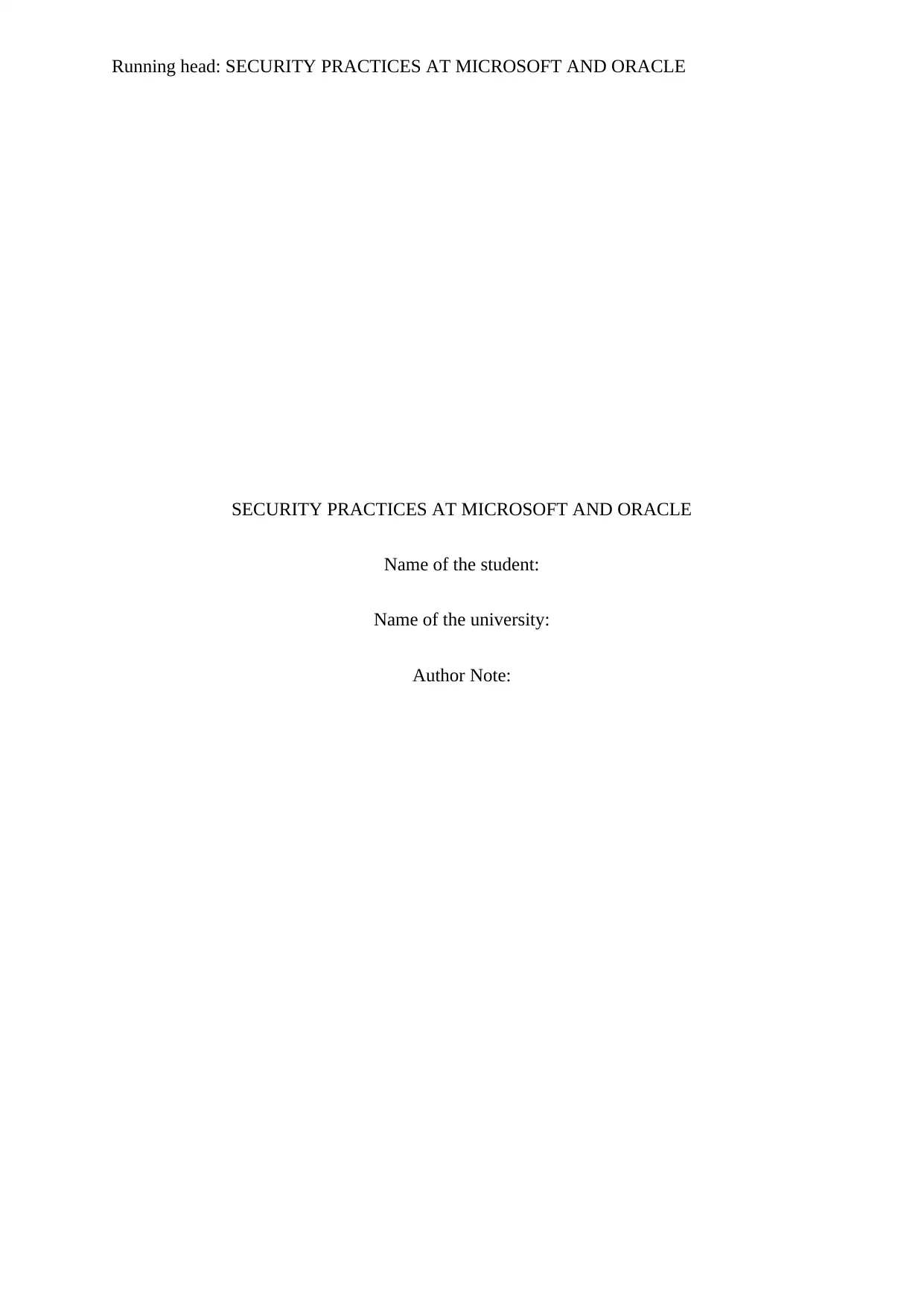
Running head: SECURITY PRACTICES AT MICROSOFT AND ORACLE
SECURITY PRACTICES AT MICROSOFT AND ORACLE
Name of the student:
Name of the university:
Author Note:
SECURITY PRACTICES AT MICROSOFT AND ORACLE
Name of the student:
Name of the university:
Author Note:
Paraphrase This Document
Need a fresh take? Get an instant paraphrase of this document with our AI Paraphraser
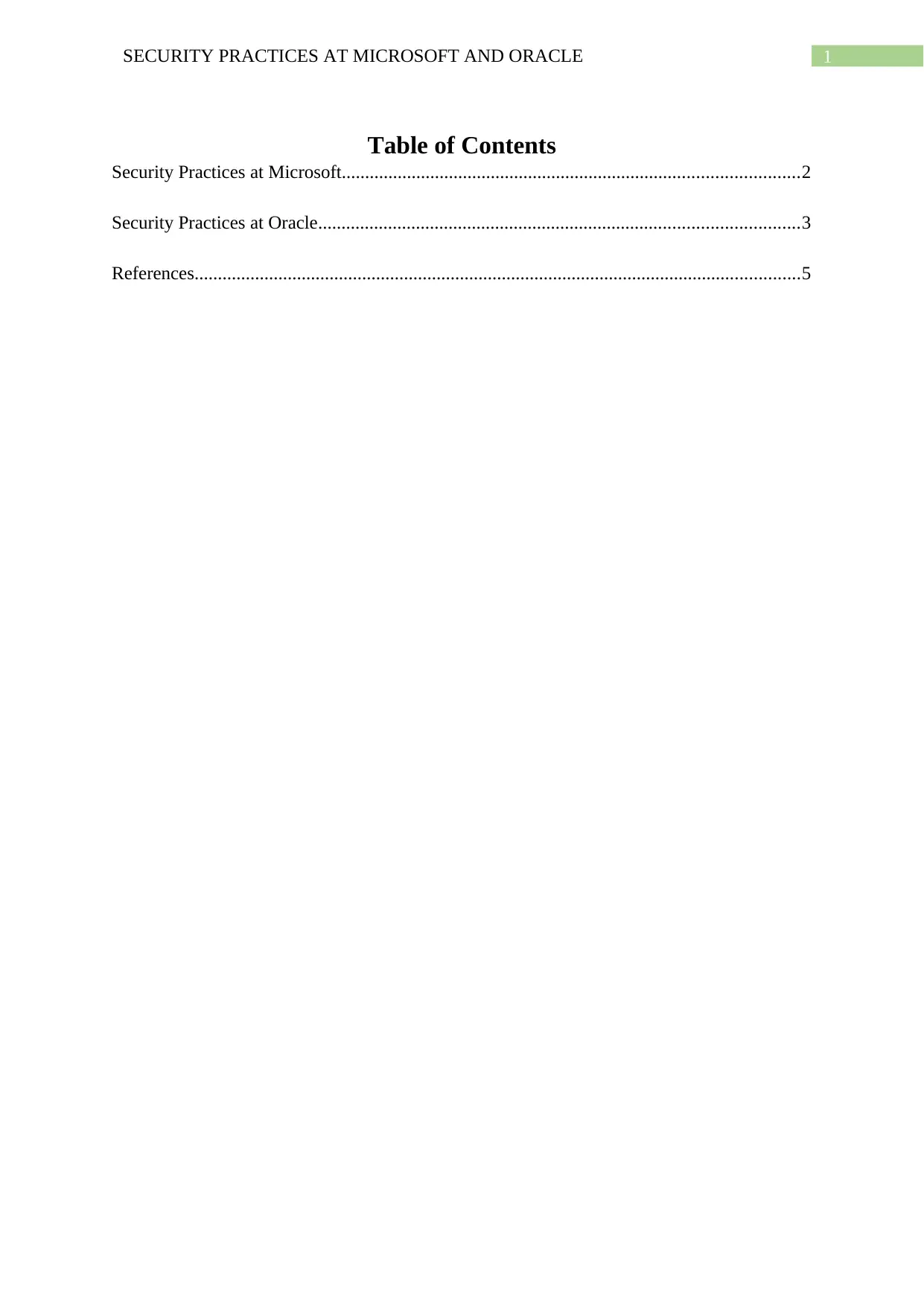
1SECURITY PRACTICES AT MICROSOFT AND ORACLE
Table of Contents
Security Practices at Microsoft..................................................................................................2
Security Practices at Oracle.......................................................................................................3
References..................................................................................................................................5
Table of Contents
Security Practices at Microsoft..................................................................................................2
Security Practices at Oracle.......................................................................................................3
References..................................................................................................................................5
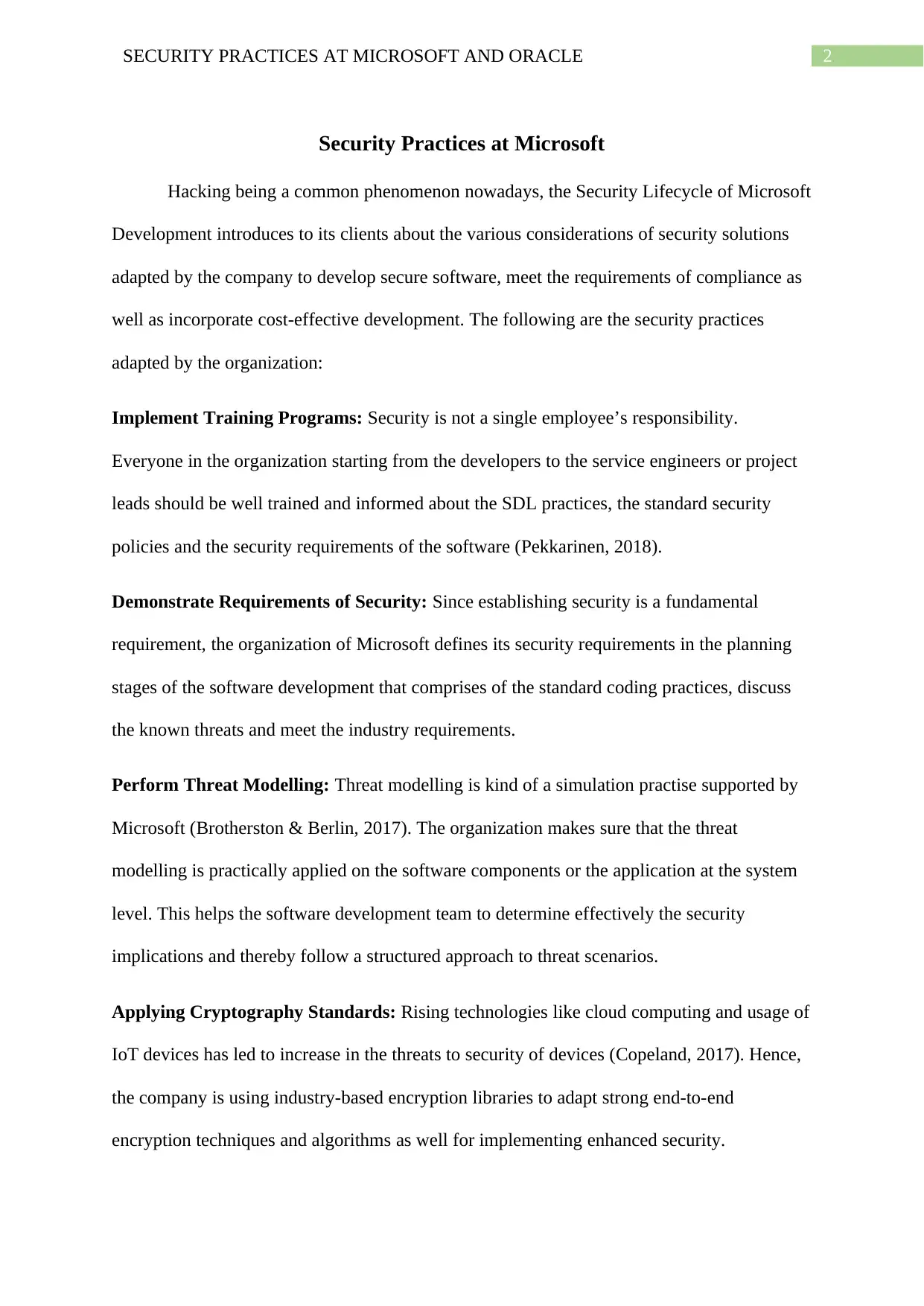
2SECURITY PRACTICES AT MICROSOFT AND ORACLE
Security Practices at Microsoft
Hacking being a common phenomenon nowadays, the Security Lifecycle of Microsoft
Development introduces to its clients about the various considerations of security solutions
adapted by the company to develop secure software, meet the requirements of compliance as
well as incorporate cost-effective development. The following are the security practices
adapted by the organization:
Implement Training Programs: Security is not a single employee’s responsibility.
Everyone in the organization starting from the developers to the service engineers or project
leads should be well trained and informed about the SDL practices, the standard security
policies and the security requirements of the software (Pekkarinen, 2018).
Demonstrate Requirements of Security: Since establishing security is a fundamental
requirement, the organization of Microsoft defines its security requirements in the planning
stages of the software development that comprises of the standard coding practices, discuss
the known threats and meet the industry requirements.
Perform Threat Modelling: Threat modelling is kind of a simulation practise supported by
Microsoft (Brotherston & Berlin, 2017). The organization makes sure that the threat
modelling is practically applied on the software components or the application at the system
level. This helps the software development team to determine effectively the security
implications and thereby follow a structured approach to threat scenarios.
Applying Cryptography Standards: Rising technologies like cloud computing and usage of
IoT devices has led to increase in the threats to security of devices (Copeland, 2017). Hence,
the company is using industry-based encryption libraries to adapt strong end-to-end
encryption techniques and algorithms as well for implementing enhanced security.
Security Practices at Microsoft
Hacking being a common phenomenon nowadays, the Security Lifecycle of Microsoft
Development introduces to its clients about the various considerations of security solutions
adapted by the company to develop secure software, meet the requirements of compliance as
well as incorporate cost-effective development. The following are the security practices
adapted by the organization:
Implement Training Programs: Security is not a single employee’s responsibility.
Everyone in the organization starting from the developers to the service engineers or project
leads should be well trained and informed about the SDL practices, the standard security
policies and the security requirements of the software (Pekkarinen, 2018).
Demonstrate Requirements of Security: Since establishing security is a fundamental
requirement, the organization of Microsoft defines its security requirements in the planning
stages of the software development that comprises of the standard coding practices, discuss
the known threats and meet the industry requirements.
Perform Threat Modelling: Threat modelling is kind of a simulation practise supported by
Microsoft (Brotherston & Berlin, 2017). The organization makes sure that the threat
modelling is practically applied on the software components or the application at the system
level. This helps the software development team to determine effectively the security
implications and thereby follow a structured approach to threat scenarios.
Applying Cryptography Standards: Rising technologies like cloud computing and usage of
IoT devices has led to increase in the threats to security of devices (Copeland, 2017). Hence,
the company is using industry-based encryption libraries to adapt strong end-to-end
encryption techniques and algorithms as well for implementing enhanced security.
⊘ This is a preview!⊘
Do you want full access?
Subscribe today to unlock all pages.

Trusted by 1+ million students worldwide
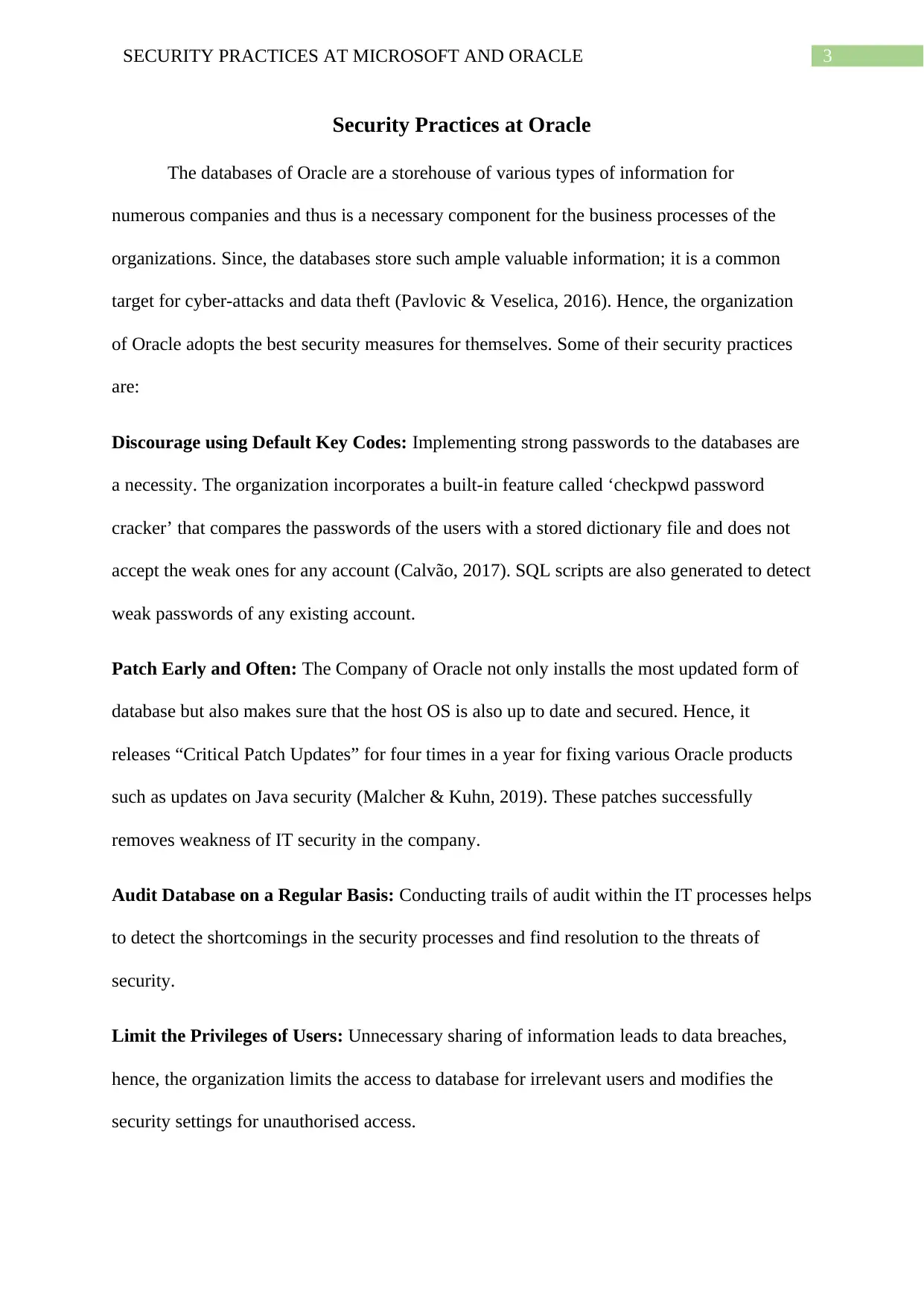
3SECURITY PRACTICES AT MICROSOFT AND ORACLE
Security Practices at Oracle
The databases of Oracle are a storehouse of various types of information for
numerous companies and thus is a necessary component for the business processes of the
organizations. Since, the databases store such ample valuable information; it is a common
target for cyber-attacks and data theft (Pavlovic & Veselica, 2016). Hence, the organization
of Oracle adopts the best security measures for themselves. Some of their security practices
are:
Discourage using Default Key Codes: Implementing strong passwords to the databases are
a necessity. The organization incorporates a built-in feature called ‘checkpwd password
cracker’ that compares the passwords of the users with a stored dictionary file and does not
accept the weak ones for any account (Calvão, 2017). SQL scripts are also generated to detect
weak passwords of any existing account.
Patch Early and Often: The Company of Oracle not only installs the most updated form of
database but also makes sure that the host OS is also up to date and secured. Hence, it
releases “Critical Patch Updates” for four times in a year for fixing various Oracle products
such as updates on Java security (Malcher & Kuhn, 2019). These patches successfully
removes weakness of IT security in the company.
Audit Database on a Regular Basis: Conducting trails of audit within the IT processes helps
to detect the shortcomings in the security processes and find resolution to the threats of
security.
Limit the Privileges of Users: Unnecessary sharing of information leads to data breaches,
hence, the organization limits the access to database for irrelevant users and modifies the
security settings for unauthorised access.
Security Practices at Oracle
The databases of Oracle are a storehouse of various types of information for
numerous companies and thus is a necessary component for the business processes of the
organizations. Since, the databases store such ample valuable information; it is a common
target for cyber-attacks and data theft (Pavlovic & Veselica, 2016). Hence, the organization
of Oracle adopts the best security measures for themselves. Some of their security practices
are:
Discourage using Default Key Codes: Implementing strong passwords to the databases are
a necessity. The organization incorporates a built-in feature called ‘checkpwd password
cracker’ that compares the passwords of the users with a stored dictionary file and does not
accept the weak ones for any account (Calvão, 2017). SQL scripts are also generated to detect
weak passwords of any existing account.
Patch Early and Often: The Company of Oracle not only installs the most updated form of
database but also makes sure that the host OS is also up to date and secured. Hence, it
releases “Critical Patch Updates” for four times in a year for fixing various Oracle products
such as updates on Java security (Malcher & Kuhn, 2019). These patches successfully
removes weakness of IT security in the company.
Audit Database on a Regular Basis: Conducting trails of audit within the IT processes helps
to detect the shortcomings in the security processes and find resolution to the threats of
security.
Limit the Privileges of Users: Unnecessary sharing of information leads to data breaches,
hence, the organization limits the access to database for irrelevant users and modifies the
security settings for unauthorised access.
Paraphrase This Document
Need a fresh take? Get an instant paraphrase of this document with our AI Paraphraser
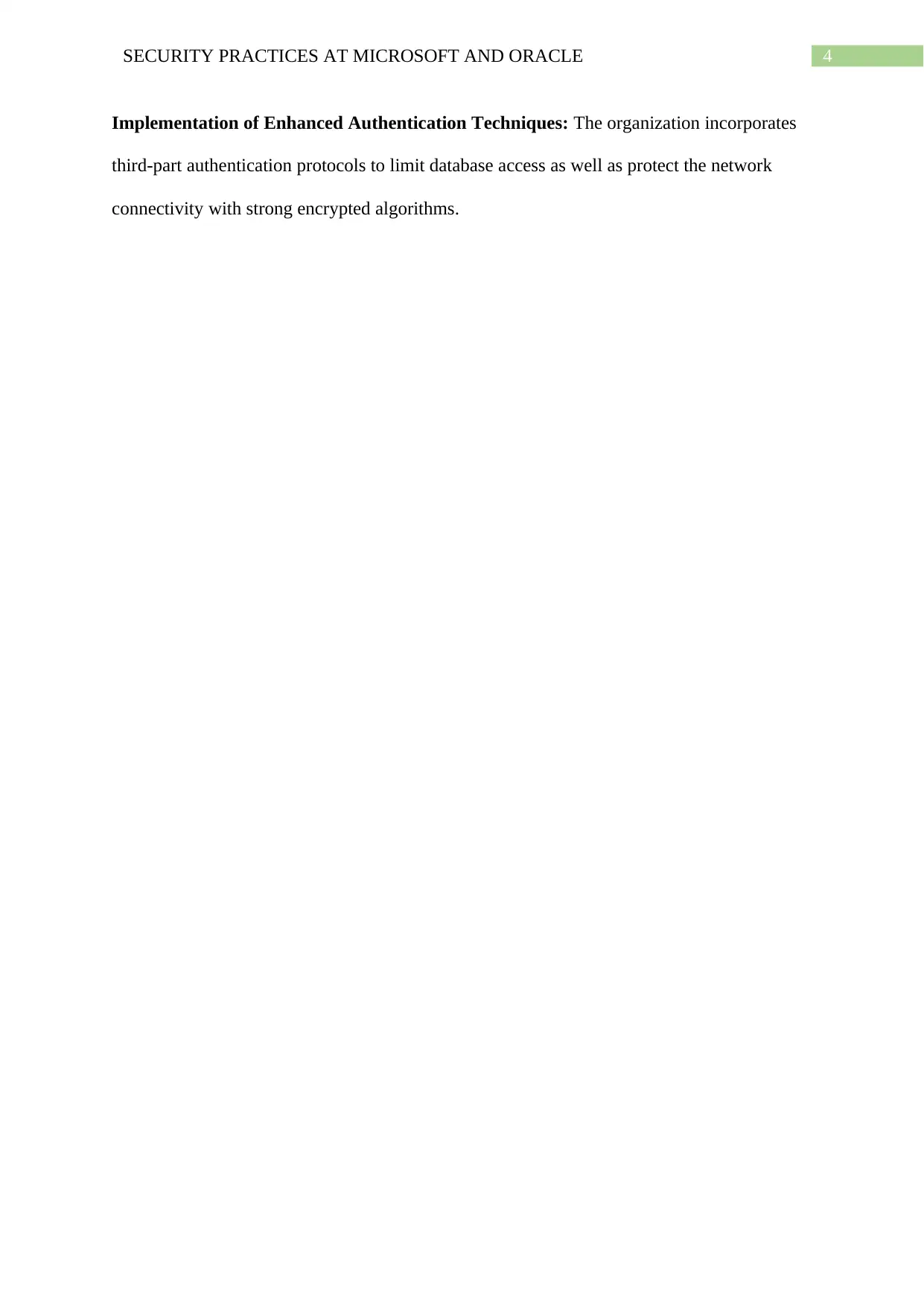
4SECURITY PRACTICES AT MICROSOFT AND ORACLE
Implementation of Enhanced Authentication Techniques: The organization incorporates
third-part authentication protocols to limit database access as well as protect the network
connectivity with strong encrypted algorithms.
Implementation of Enhanced Authentication Techniques: The organization incorporates
third-part authentication protocols to limit database access as well as protect the network
connectivity with strong encrypted algorithms.
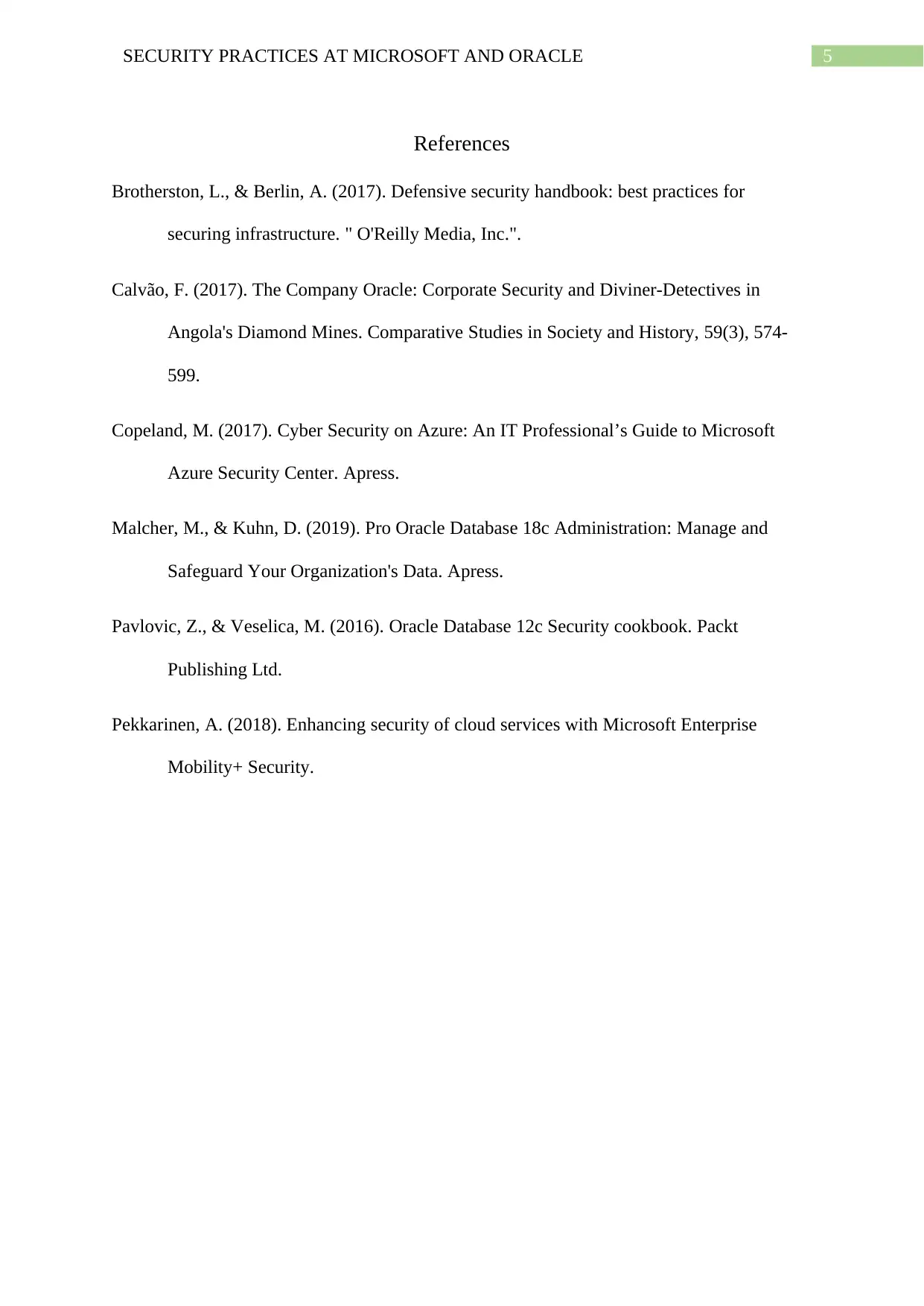
5SECURITY PRACTICES AT MICROSOFT AND ORACLE
References
Brotherston, L., & Berlin, A. (2017). Defensive security handbook: best practices for
securing infrastructure. " O'Reilly Media, Inc.".
Calvão, F. (2017). The Company Oracle: Corporate Security and Diviner-Detectives in
Angola's Diamond Mines. Comparative Studies in Society and History, 59(3), 574-
599.
Copeland, M. (2017). Cyber Security on Azure: An IT Professional’s Guide to Microsoft
Azure Security Center. Apress.
Malcher, M., & Kuhn, D. (2019). Pro Oracle Database 18c Administration: Manage and
Safeguard Your Organization's Data. Apress.
Pavlovic, Z., & Veselica, M. (2016). Oracle Database 12c Security cookbook. Packt
Publishing Ltd.
Pekkarinen, A. (2018). Enhancing security of cloud services with Microsoft Enterprise
Mobility+ Security.
References
Brotherston, L., & Berlin, A. (2017). Defensive security handbook: best practices for
securing infrastructure. " O'Reilly Media, Inc.".
Calvão, F. (2017). The Company Oracle: Corporate Security and Diviner-Detectives in
Angola's Diamond Mines. Comparative Studies in Society and History, 59(3), 574-
599.
Copeland, M. (2017). Cyber Security on Azure: An IT Professional’s Guide to Microsoft
Azure Security Center. Apress.
Malcher, M., & Kuhn, D. (2019). Pro Oracle Database 18c Administration: Manage and
Safeguard Your Organization's Data. Apress.
Pavlovic, Z., & Veselica, M. (2016). Oracle Database 12c Security cookbook. Packt
Publishing Ltd.
Pekkarinen, A. (2018). Enhancing security of cloud services with Microsoft Enterprise
Mobility+ Security.
⊘ This is a preview!⊘
Do you want full access?
Subscribe today to unlock all pages.

Trusted by 1+ million students worldwide
1 out of 6
Related Documents
Your All-in-One AI-Powered Toolkit for Academic Success.
+13062052269
info@desklib.com
Available 24*7 on WhatsApp / Email
![[object Object]](/_next/static/media/star-bottom.7253800d.svg)
Unlock your academic potential
Copyright © 2020–2025 A2Z Services. All Rights Reserved. Developed and managed by ZUCOL.




